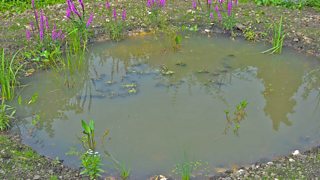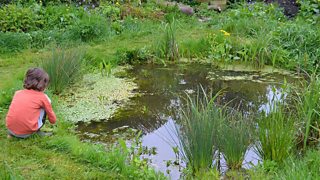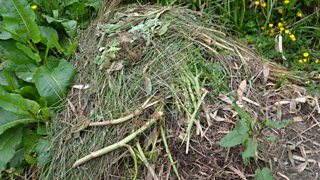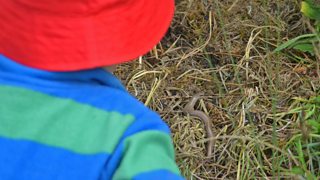By Peter Hill, Connecting the Dragons Project Officer at Amphibian and Reptile Conservation

One month old garden pond 漏 Pete Hill ARC
Ponds bring in the wildlife quickly
Lockdown certainly doesn’t apply to wildlife, and so we have been busy in our garden tweaking it further to suit some of our occasional wilder visitors. I work with amphibians and reptiles, creating habitat for them across the whole of Wales, but it shouldn’t stop there. There is plenty we can all do to benefit native amphibians and reptiles in our gardens as well.
We created a pond three seasons ago; the images show how it has developed since then. Birds use the pond by day and bats hunt over it by night. Dragonflies and damselflies breed here, and we have common frogs and palmate newts breeding too as well as the occasional toad visiting.

One year old garden pond 漏 Pete Hill ARC
Provide an egg-laying site for grass snakes
We have been letting the lawn grow during lockdown as part of the “No Mow May” campaign, which will provide much needed forage for bees and other invertebrates, but we have also been focussing on some other garden-based habitat creation. Last Summer we were privileged to have a female grass snake visit, no doubt on the hunt for some amphibian prey - just as nature intended!
So this year we have created a heat-generating mound of organic material to hopefully provide an egg-laying site for any female grass snakes that may return this year. We have made a heap of grass cuttings, leaf litter (from earlier in the year) and any other garden waste (such as pruning’s and clippings) and situated it in a quiet corner in the full sun. We’ll keep on adding to it until mid-June and see what happens. Grass snake eggs generally hatch in late August or early September.

Garden pond grass snake 漏 Pete Hill ARC

Garden grass snake egg laying mound 漏 Pete Hill ARC
Become a herpetologist
Do you have amphibians and reptiles in your garden? Maybe hidden away in the quiet sunny corners or in your compost heap? Slow-worms are a great species to survey, they're great allies to the gardener and children love to see them!
If you have spent the lockdown creating a wildlife haven in your garden, you are only a few easy steps away to becoming a herpetologist (someone who studies amphibians and reptiles). Take time outside exploring your own garden to find out who is now living on your patch.

Child and male slow worm
Take part in citizen science
Spend around 10 to 15 minutes looking in places where reptiles or amphibians are likely to be spotted such as: in or around ponds or compost heaps, at the bottom of hedgees or garden borders, near logs, slates or rock piles. Tell us what you find (or if you don’t find anything!). Fill in the online form with your results and answer a few questions about the habitats inside your garden and nearby.
You can do the survey once or several times. Ideally repeat the survey regularly, perhaps once a week – these species can be shy and hard to find. Try to spend roughly the same time looking each time you do the survey. By going out repeatedly you are more likely to find one and you will also learn the changes you see through the season. You can adjust the amount of time to suit your own garden and the time you have available.

Female common toad at edge of garden pond 漏 Pete Hill ARC
